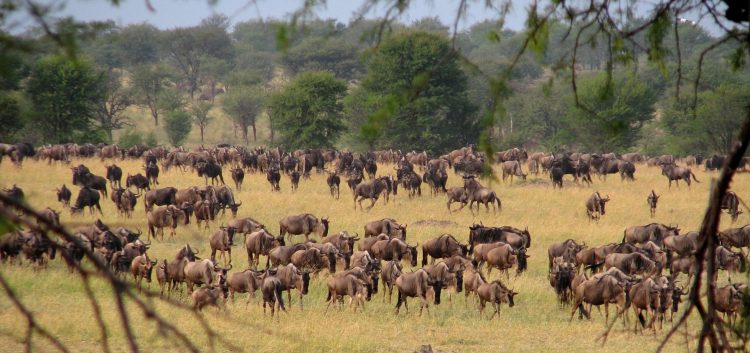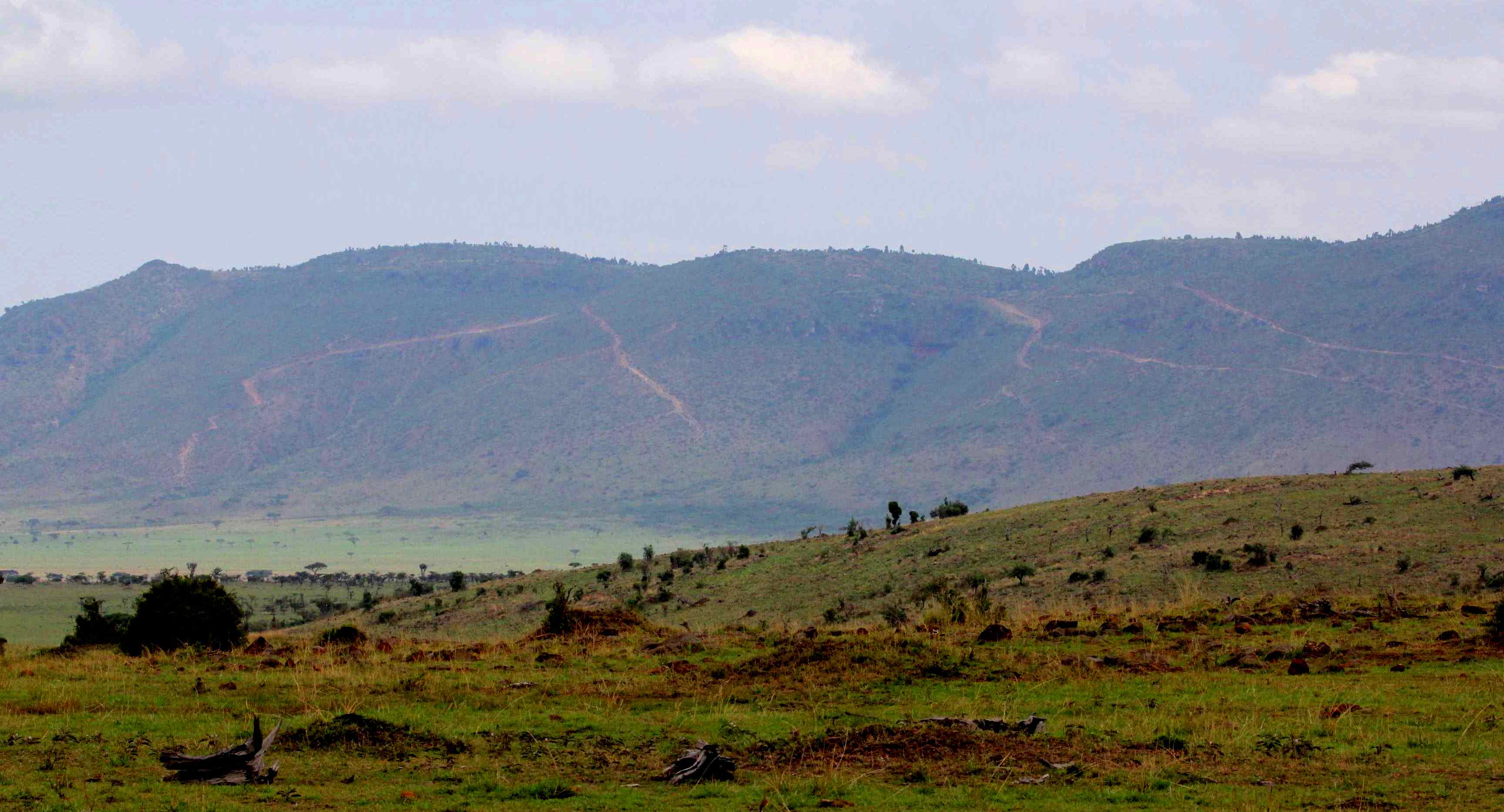July 22, 2018
Nearly 2 million animals, mostly wildebeest and zebra, migrate roughly 800 kilometers (500 miles) each year between Serengeti National Park in Tanzania and Maasai Mara National Reserve across the border in Kenya. Their joint search for fresh green grass is an ecological phenomenon and a major tourist attraction in both countries.
But along with tourists, this profusion of animals also attracts bushmeat poachers. Each year, poachers from the western edge of the Serengeti follow the herd into Kenya. Along the way, they kill between 40,000 and 100,000 wildebeest, zebra and other grazers each year, according to Brian Heath, CEO of the Mara Conservancy.
The conservancy manages a portion of the Maasai Mara reserve called the Mara Triangle, perhaps best known for the annual crossing by the wildebeest of the crocodile-laden Mara River.

Heath spoke with Mongabay-Wildtech about security, his biggest conservation challenge there, as well as his team’s use of forward-looking infrared (FLIR) thermal imaging sensors in their ongoing effort to keep poaching of the famous migrating wildebeest and other wildlife at bay.
Poachers typically kill the animals by setting wire snares, made from steel stripped from old tires. “There’s a whole business doing this,” Heath said, referring to local production of the many thousands of snares used illegally within the two reserves. “Last year we collected 7,000 snares [in the Mara Triangle], the year before was the same.”

The Mara Conservancy rangers are authorized to work along the border and within adjacent Serengeti National Park in Tanzania. At the height of the northward migration in July and August 2017, Heath’s team in the Mara and Tanzanian colleagues in the Serengeti collected some 12,000 snares. The problem with snaring, Heath said, is that it’s indiscriminate. Snares are set primarily for wildebeest but catch everything, including lions, rhinos, elephants, cheetahs, and hyenas, killing or wounding thousands that break loose with the snare still on them.
After the migration ends, poachers take other species, mostly for meat. “They hunt gazelle with dogs and are very effective,” Heath said. “They come in large groups, up to 30 poachers, and are constantly moving.”

The intruders kill one or two elephants for ivory each year, fewer than in many surrounding natural areas. Bushmeat poachers, armed primarily with bows and arrows, will run from but rarely fight with Heath’s patrol teams. Nevertheless, in the dark, the rangers cannot see poachers.
The advantage of night vision technology
In 2016, the Mara Conservancy began using FLIR thermal cameras, provided and set up by World Wildlife Fund’s Wildlife Crime Technology Project, to find and capture poachers at night, when they are most active. Thermal sensors detect heat rather than light, so they enable the user to see the heat emitted by various surfaces, even at night. People and large mammals, in particular, stand out from the surrounding landscape.

Prior to the introduction of the FLIR equipment, up to several hundred poachers each night would walk down a steep escarpment that lies along the western border of both reserves.
The poachers trespass 5–10 kilometers into the park, set their snares, and leave them for several hours to trap the unsuspecting antelope and zebras. By dawn, they have checked the snares, butchered the captured animals, and left the park for the safety of their villages.
So every morning, two ranger teams each patrol an area at random. If they see any hint of poaching, they’ll set up an ambush or just go out that night. They’ve made the thermal cameras mobile by installing them on vehicles.
In the past, finding bushmeat poachers in the Mara was like finding a needle in a haystack. Now, with the vehicle-mounted FLIR cameras, “we can pick these people up from 1 km [0.6 miles] away,” Heath said.

The thermal cameras can pan left and right, thereby sweeping across a large area. One ranger operates each one and tells his colleagues by radio from which direction the poachers are approaching and whether or not any dangerous animals are nearby. With that information, the rangers position themselves in wait, using smaller handheld FLIR cameras, which enable them to monitor approaching poachers up to 100 meters (300 feet) away in the dark, and radios to let the operator know where they are.
Digital radios are a key component of the night patrol teams: catching poachers, even with the high-tech FLIR thermal devices, requires ranger communication and cooperation. Each ranger team has one or two radio operators, so there is always a backup if one person is not available. Each patrol team also carries two or three radios to be sure that at least one is working.
The patrols relish being able to pick out the poachers at night. “The rangers feel a bit blind and naked without it,” Heath said.
Even with the thermal sensors, however, differentiating poacher from ranger at night is difficult. Rangers must know each other’s location and understand poacher behavior — a person diving into a bush to hide is probably a poacher. They have considered providing thermal patches for rangers to wear and distinguish themselves to the sensors, but that technology is still financially prohibitive.

Another challenge the ranger teams face is when they assist Tanzanian colleagues within Serengeti, outside the range of their radio repeater, so the radio operator at their central headquarters cannot keep track of them there. Rangers can speak to each other via certain channels, but they cannot communicate with their headquarters.
Nevertheless, the thermal devices have “radically changed their success,” Heath said. “Well over 100 people have been caught specifically by using the FLIR cameras,” and poachers don’t understand how they’re suddenly being detected at night.
The elevated capture rate is beginning to have a big impact. “In the past, we would never have found these people,” Heath told Wired UK. “Now the poachers are saying it’s just not worth going out, because the chance of getting caught is getting higher and higher. It has been a big deterrent.”
Roaming cattle rustlers
When Heath arrived in the Maasai Mara reserve in 2001, the roads were impassable and vehicles non-functional. Two-thirds of the Mara Triangle was unsafe for both residents and visitors. Cattle rustling was rampant, and bushmeat poachers regularly camped in tents along the Mara River, hunting hippos and carrying the meat out on donkeys. By contrast, Heath said, “I don’t think there’s been an incident [of cattle rustling] in the last 10 years,” and just one hippo has been butchered this year.
“A lot of Tanzanian poachers would camp out for days on end, catch game with snares, butcher them, and dry the meat,” Heath said. “Now there are almost no poachers. We’ve pushed the bulk of the poaching to areas that are within an easy walk from their village. We keep them focused within 3–5 kilometers [2 to 3 miles] of their homestead.”
Heath attributed the Mara Conservancy’s success to a good radio communications system, reliable vehicles, and a well-motivated and trained staff. The icing on the cake is the FLIR cameras that now enable them to work successfully 24/7.
The thermal imaging technology has not disappointed them. “It’s as good as we hoped,” Heath said. “Tech gets better and better.”
This article was written by Sue Palminteri and first published by Mongabay.com on 09 Jul 2018.











Đăng nhận xét